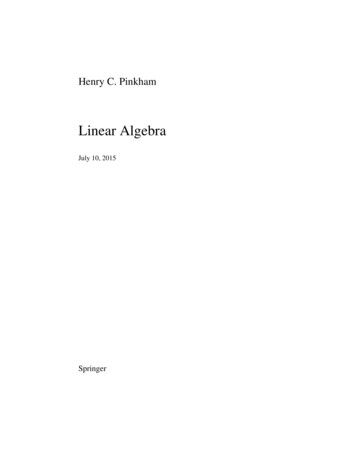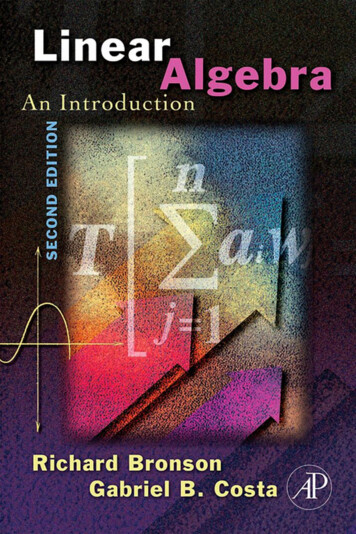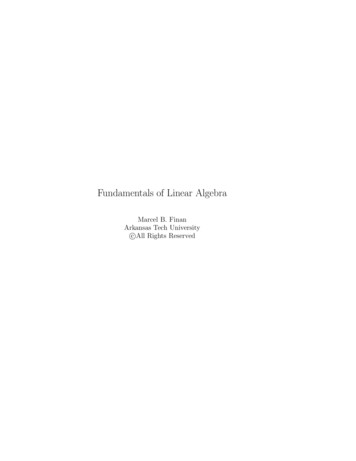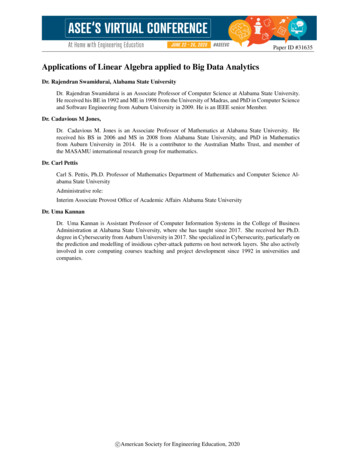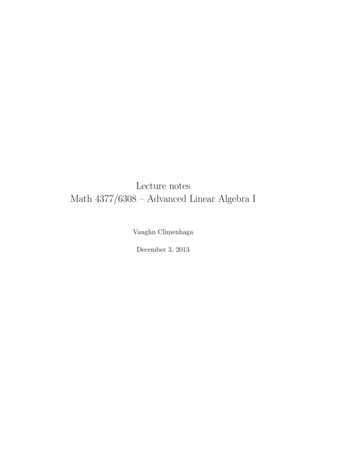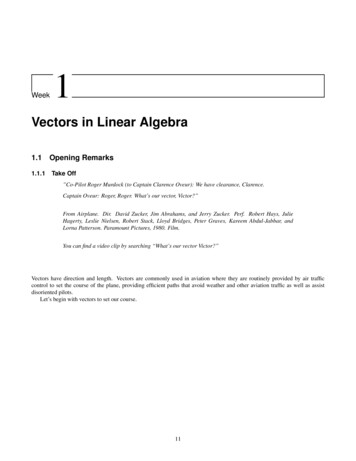
Transcription
Week1Vectors in Linear Algebra1.11.1.1Opening RemarksTake Off”Co-Pilot Roger Murdock (to Captain Clarence Oveur): We have clearance, Clarence.Captain Oveur: Roger, Roger. What’s our vector, Victor?”From Airplane. Dir. David Zucker, Jim Abrahams, and Jerry Zucker. Perf. Robert Hays, JulieHagerty, Leslie Nielsen, Robert Stack, Lloyd Bridges, Peter Graves, Kareem Abdul-Jabbar, andLorna Patterson. Paramount Pictures, 1980. Film.You can find a video clip by searching “What’s our vector Victor?”Vectors have direction and length. Vectors are commonly used in aviation where they are routinely provided by air trafficcontrol to set the course of the plane, providing efficient paths that avoid weather and other aviation traffic as well as assistdisoriented pilots.Let’s begin with vectors to set our course.11
Week 1. Vectors in Linear Algebra1.1.212Outline Week 11.1. Opening Remarks . . . . . . . . . . . . . . . . . . . . .1.1.1. Take Off . . . . . . . . . . . . . . . . . . . . . .1.1.2. Outline Week 1 . . . . . . . . . . . . . . . . . . .1.1.3. What You Will Learn . . . . . . . . . . . . . . . .1.2. What is a Vector? . . . . . . . . . . . . . . . . . . . . .1.2.1. Notation . . . . . . . . . . . . . . . . . . . . . . .1.2.2. Unit Basis Vectors . . . . . . . . . . . . . . . . .1.3. Simple Vector Operations . . . . . . . . . . . . . . . . .1.3.1. Equality ( ), Assignment (: ), and Copy . . . . .1.3.2. Vector Addition (ADD) . . . . . . . . . . . . . . .1.3.3. Scaling (SCAL) . . . . . . . . . . . . . . . . . . .1.3.4. Vector Subtraction . . . . . . . . . . . . . . . . .1.4. Advanced Vector Operations . . . . . . . . . . . . . . .1.4.1. Scaled Vector Addition (AXPY) . . . . . . . . . .1.4.2. Linear Combinations of Vectors . . . . . . . . . .1.4.3. Dot or Inner Product (DOT) . . . . . . . . . . . . .1.4.4. Vector Length (NORM 2) . . . . . . . . . . . . . .1.4.5. Vector Functions . . . . . . . . . . . . . . . . . .1.4.6. Vector Functions that Map a Vector to a Vector . .1.5. LAFF Package Development: Vectors . . . . . . . . . .1.5.1. Starting the Package . . . . . . . . . . . . . . . .1.5.2. A Copy Routine (copy) . . . . . . . . . . . . . . .1.5.3. A Routine that Scales a Vector (scal) . . . . . . . .1.5.4. A Scaled Vector Addition Routine (axpy) . . . . .1.5.5. An Inner Product Routine (dot) . . . . . . . . . .1.5.6. A Vector Length Routine (norm2) . . . . . . . . .1.6. Slicing and Dicing . . . . . . . . . . . . . . . . . . . . .1.6.1. Slicing and Dicing: Dot Product . . . . . . . . . .1.6.2. Algorithms with Slicing and Redicing: Dot Product1.6.3. Coding with Slicing and Redicing: Dot Product . .1.6.4. Slicing and Dicing: axpy . . . . . . . . . . . . . .1.6.5. Algorithms with Slicing and Redicing: axpy . . . .1.6.6. Coding with Slicing and Redicing: axpy . . . . . .1.7. Enrichment . . . . . . . . . . . . . . . . . . . . . . . . .1.7.1. Learn the Greek Alphabet . . . . . . . . . . . . .1.7.2. Other Norms . . . . . . . . . . . . . . . . . . . .1.7.3. Overflow and Underflow . . . . . . . . . . . . . .1.7.4. A Bit of History . . . . . . . . . . . . . . . . . .1.8. Wrap Up . . . . . . . . . . . . . . . . . . . . . . . . . .1.8.1. Homework . . . . . . . . . . . . . . . . . . . . .1.8.2. Summary of Vector Operations . . . . . . . . . . .1.8.3. Summary of the Properties of Vector Operations .1.8.4. Summary of the Routines for Vector Operations . 7373838383940414142424246464747515152
1.1. Opening Remarks1.1.313What You Will LearnUpon completion of this week, you should be able to Represent quantities that have a magnitude and a direction as vectors. Read, write, and interpret vector notations. Visualize vectors in R2 . Perform the vector operations of scaling, addition, dot (inner) product. Reason and develop arguments about properties of vectors and operations defined on them. Compute the (Euclidean) length of a vector. Express the length of a vector in terms of the dot product of that vector with itself. Evaluate a vector function. Solve simple problems that can be represented with vectors. Create code for various vector operations and determine their cost functions in terms of the size of the vectors. Gain an awareness of how linear algebra software evolved over time and how our programming assignments fit into this(enrichment). Become aware of overflow and underflow in computer arithmetic (enrichment).
Week 1. Vectors in Linear Algebra1.21.2.114What is a Vector?Notation* View at edXDefinitionDefinition 1.1 We will call a one-dimensional array of n numbers a vector of size n: χ0 χ1 x . . χn 1 . This is an ordered array. The position in the array is important. We will call the ith number the ith component or element. We denote the ith component of x by χi . Here χ is the lower case Greek letter pronounced as “kı”. (Learn more about ournotational conventions in Section 1.7.1.)As a rule, we will use lower case letters to name vectors (e.g., x, y, .). The “corresponding” Greek lower case letters areused to name their components. We start indexing at 0, as computer scientists do.MATLAB, the tool we will be using to implement our libraries,naturally starts indexing at 1, as do most mathematicians and physical scientists. You’ll have to get use to this. Each number is, at least for now, a real number, which in math notation is written as χi R (read: “ki sub i (is) in r” or“ki sub i is an element of the set of all real numbers”). The size of the vector is n, the number of components. (Sometimes, people use the words “length” and “size” interchangeably. We will see that length also has another meaning and will try to be consistent.) We will write x Rn (read: “x” in “r” “n”) to denote that x is a vector of size n with components in the real numbers,denoted by the symbol: R. Thus, Rn denotes the set of all vectors of size n with components in R. (Later we will talkabout vectors with components that are complex valued.) A vector has a direction and a length:– Its direction is often visualized by drawing an arrow from the origin to the point (χ0 , χ1 , . . . , χn 1 ), but the arrowdoes not necessarily need to start at the origin.– Its length is given by the Euclidean length of this arrow,qχ20 χ21 · · · χ2n 1 ,It is denoted by kxk2 called the two-norm. Some people also call this the magnitude of the vector. A vector does not have a location. Sometimes we will show it starting at the origin, but that is only for convenience. Itwill often be more convenient to locate it elsewhere or to move it.
1.2. What is a Vector?15ExamplesExample 1.2 Consider x 4 3 . Then Components 4 and 3 are the first and second component, respectively. χ0 4, χ1 3 so that 4 is the component indexed with0 and 3 the component indexed with 1. The vector is of size 2, so x R2 .ExercisesHomework 1.2.1.1 Consider the following picture:Using the grid for units,(a) x x(c) x 2 32 3 (b) x (d) x (e) None of these3 2 3 2
Week 1. Vectors in Linear Algebra16Homework 1.2.1.2Consider the following picture:Using the grid for units, bgafe(a) a (b) b (c) c (d) d (e) e (f) f (g) g dcWhile a vector does not have a location, but has direction and length, vectors are often used to show the directionlength and of movement from one location to another. For example, the vector from point (1, 2) to point (5, 1) is the vector might geometrically represent the vector 4343 by an arrow from point (1, 2) to point (5, 1).Homework 1.2.1.3 Write each of the following as a vector: The vector represented geometrically in R2 by an arrow from point ( 1, 2) to point (0, 0). The vector represented geometrically in R2 by an arrow from point (0, 0) to point ( 1, 2). The vector represented geometrically in R3 by an arrow from point ( 1, 2, 4) to point (0, 0, 1). The vector represented geometrically in R3 by an arrow from point (1, 0, 0) to point (4, 2, 1).1.2.2Unit Basis Vectors* View at edXDefinitionDefinition 1.3 An important set of vectors is the set of unit basis vectors given by 0 . . j zeroes . 0 ej component indexed by j 1 0 . . n j 1 zeroes 0 . We
1.3. Simple Vector Operations17where the “1” appears as the component indexed by j. Thus, we get the set {e0 , e1 , . . . , en 1 } Rn given by 1 e0 0. 0 e1 1. , 0 0 0 en 1 0. , 0 0···, . 0 1In our presentations, any time you encounter the symbol e j , it always refers to the unit basis vector with the “1” in the componentindexed by j.These vectors are also referred to as the standard basis vectors. Other terms used for these vectors are natural basis andcanonical basis. Indeed, “unit basis vector” appears to be less commonly used. But we will use it anyway!Homework 1.2.2.1 Which of the following is not a unit basis vector? 0 0 (a) 1 01.31.3.1 (b) 01 (c) 2 222 1 (d) 0 0(e) None of these are unit basisvectors.Simple Vector OperationsEquality ( ), Assignment (: ), and Copy* View at edXDefinitionDefinition 1.4 Two vectors x, y Rn are equal if all their components are element-wise equal:x y if and only if χi ψi , for all 0 i n.This means that two vectors are equal if they point in the same direction and are of the same length. They don’t, however,need to have the same location.The assignment or copy operation assigns the content of one vector to another vector. In our mathematical notation, we willdenote this by the symbol : (pronounce: becomes). After the assignment, the two vectors are equal to each other.AlgorithmThe following algorithm copies vector x Rn into vector y Rn , performing the operation y : x: ψ0 ψ1 . . ψn 1 χ0 χ1 : . . χn 1
Week 1. Vectors in Linear Algebra18for i 0, . . . , n 1ψi : χiendforCost(Notice: we will cost of various operations in more detail in the future.)Copying one vector to another vector requires 2n memory operations (memops). The vector x of length n must be read, requiring n memops and the vector y must be written, which accounts for the other n memops.Homework 1.3.1.1 Decide if the two vectors are equal. The vector represented geometrically in R2 by an arrow from point ( 1, 2) to point (0, 0) and the vectorrepresented geometrically in R2 by an arrow from point (1, 2) to point (2, 1) are equal.True/False The vector represented geometrically in R3 by an arrow from point (1, 1, 2) to point (0, 0, 0) and the vectorrepresented geometrically in R3 by an arrow from point (1, 1, 2) to point (0, 2, 4) are equal.True/False1.3.2Vector Addition (ADD)* View at edXDefinitionDefinition 1.5 Vector addition x y (sum of vectors) is defined by χ0 χ1 x y . . χn 1 ψ0 ψ1 . . ψn 1 χ0 ψ0 χ1 ψ1. . χn 1 ψn 1In other words, the vectors are added element-wise, yielding a new vector of the same size.Exercises Homework 1.3.2.1 Homework 1.3.2.2 12 3 2 3 2 12
1.3. Simple Vector Operations19Homework 1.3.2.3 For x, y Rn ,x y y x.Always/Sometimes/Never Homework 1.3.2.4 12 Homework 1.3.2.5 12 3 2 3 2 12 12 Homework 1.3.2.6 For x, y, z Rn , (x y) z x (y z). Homework 1.3.2.7 12 00Always/Sometimes/Never Homework 1.3.2.8 For x Rn , x 0 x, where 0 is the zero vector of appropriate size.Always/Sometimes/NeverAlgorithmThe following algorithm assigns the sum of vectors x and y (of size n and stored in arrays x and y) to vector z (of size n andstored in array z), computing z : x y: ζ0χ0 ψ0 ζ1 χ1 ψ 1 . : . . . ζn 1χn 1 ψn 1for i 0, . . . , n 1ζi : χi ψiendforCostOn a computer, real numbers are stored as floating point numbers, and real arithmetic is approximated with floating pointarithmetic. Thus, we count floating point operations (flops): a multiplication or addition each cost one flop.Vector addition requires 3n memops (x is read, y is read, and the resulting vector is written) and n flops (floating pointadditions).For those who understand “Big-O” notation, the cost of the SCAL operation, which is seen in the next section, is O(n).However, we tend to want to be more exact than just saying O(n). To us, the coefficient in front of n is important.Vector addition in sportsView the following video and find out how the “parallelogram method” for vector addition is useful in sports:http://www.nsf.gov/news/special reports/football/vectors.jspDiscussion: Can you find other examples of how vector addition is used in sports?
Week 1. Vectors in Linear Algebra1.3.320Scaling (SCAL)* View at edXDefinitionDefinition 1.6 Multiplying vector x by scalar α yields a new vector, αx, in the same direction as x, but scaled by a factor α.Scaling a vector by α means each of its components, χi , is multiplied by α: χ0 χ1 αx α . . χn 1αχ0 αχ1 . . αχn 1 . Exercises Homework 1.3.3.1 Homework 1.3.3.2 3 12 12 12 12 Homework 1.3.3.3 Consider the following picture:bgafedcWhich vector equals 2a?; (1/2)a? ; and (1/2)a?
1.3. Simple Vector Operations21AlgorithmThe following algorithm scales a vector x Rn by α, overwriting x with the result αx: χ0 χ1 . . χn 1αχ0 αχ1 : . . αχn 1 . for i 0, . . . , n 1χi : αχiendforCostScaling a vector requires n flops and 2n 1 memops. Here, α is only brought in from memory once and kept in a register forreuse. To fully understand this, you need to know a little bit about computer architecture.“Among friends” we will simply say that the cost is 2n memops since the one extra memory operation (to bring α in frommemory) is negligible.1.3.4Vector Subtraction* View at edXRecall the geometric interpretation for adding two vectors, x, y Rn :xyy xx yyxSubtracting y from x is defined asx y x ( y).We learned in the last unit that y is the same as ( 1)y which is the same as pointing y in the opposite direction, while keepingit’s length the same. This allows us to take the parallelogram that we used to illustrate vector addition
Week 1. Vectors in Linear Algebra22xyyxand change it into the equivalent picturex y yxSince we know how to add two vectors, we can now illustrate x ( y):x yx ( y) yxWhich then means that x y can be illustrated by
1.4. Advanced Vector Operations23xyyx yxFinally, we note that the parallelogram can be used to simulaneously illustrate vector addition and subtraction:xyx yx yyx(Obviously, you need to be careful to point the vectors in the right direction.)Now computing x y when x, y Rn is a simple matter of subtracting components of y off the corresponding componentsof x: χ0ψ0χ0 ψ0 χ1 ψ1 χ1 ψ1 x y . . . . . . χn 1ψn 1χn 1 ψn 1Homework 1.3.4.1 For x Rn , x x 0.Always/Sometimes/NeverHomework 1.3.4.2 For x, y Rn , x y y x.Always/Sometimes/Never1.41.4.1Advanced Vector OperationsScaled Vector Addition (AXPY)* View at edX
Week 1. Vectors in Linear Algebra24DefinitionDefinition 1.7 One of the most commonly encountered operations when implementing more complex linear algebra operationsis the scaled vector addition, which (given x, y Rn ) computes y : αx y: χ0 χ1 αx y α . . χn 1 ψ0 ψ1 . . ψn 1 αχ0 ψ0 αχ1 ψ1. . αχn 1 ψn 1It is often referred to as the AXPY operation, which stands for alpha times x plus y. We emphasize that it is typically used insituations where the output vector overwrites the input vector y.AlgorithmObviously, one could copy x into another vector, scale it by α, and then add it to y. Usually, however, vector y is simply updatedone element at a time: ψ0αχ0 ψ0 ψ1 αχ1 ψ1 . : . . . ψn 1αχn 1 ψn 1for i 0, . . . , n 1ψi : αχi ψiendforCostIn Section 1.3 for many of the operations we discuss the cost in terms of memory operations (memops) and floating pointoperations (flops). This is discussed in the text, but not the videos. The reason for this is that we will talk about the cost ofvarious operations later in a larger context, and include these discussions here more for completely.Homework 1.4.1.1 What is the cost of an axpy operation? How many memops? How many flops?1.4.2Linear Combinations of Vectors* View at edXDiscussionThere are few concepts in linear algebra more fundamental than linear combination of vectors.
1.4. Advanced Vector Operations25DefinitionDefinition 1.8 Let u, v Rm and α, β R. Then αu βv is said to be a linear combination of vectors u and v: αυ0 βν0βν0αυ0ν0υ0 ν1 αυ1 βν1 υ1 αυ1 βν1 αu βv α . β . . . . . . αυm 1 βνm 1βνm 1αυm 1νm 1υm 1The scalars α and β are the coefficients used in the linear combination.More generally, if v0 , . . . , vn 1 Rm are n vectors and χ0 , . . . , χn 1 R are n scalars, then χ0 v0 χ1 v1 · · · χn 1 vn 1 isa linear combination of the vectors, with coefficients χ0 , . . . , χn 1 .We will often use the summation notation to more concisely write such a linear combination:n 1χ0 v0 χ1 v1 · · · χn 1 vn 1 χ jv j.j 0Homework 1.4.2.1 2 1 4 0 3 2 1 1 00Homework 1.4.2.2 1 0 0 3 0 2 1 4 0 010Homework 1.4.2.3 Find α, β, γ such that 100 α 0 β 1 γ 0010α β 2 1 3γ AlgorithmGiven v0 , . . . , vn 1 Rm and χ0 , . . . , χn 1 R the linear combination w χ0 v0 χ1 v1 · · · χn 1 vn 1 can be computed byfirst setting the result vector w to the zero vector of size m, and then performing n AXPY operations:w 0(the zero vector of size m)for j 0, . . . , n 1w : χ j v j wendforThe axpy operation computed y : αx y. In our algorithm, χ j takes the place of α, v j the place of x, and w the place of y.
Week 1. Vectors in Linear Algebra26CostWe noted that computing w χ0 v0 χ1 v1 · · · χn 1 vn 1 can be implementated as n AXPY operations. This suggests that thecost is n times the cost of an AXPY operation with vectors of size m: n (2m) 2mn flops and (approximately) n (3m)memops.However, one can actually do better. The vector w is updated repeatedly. If this vector stays in the L1 cache of a computer,then it needs not be repeatedly loaded from memory, and the cost becomes m memops (to load w into the cache) and thenfor each AXPY operation (approximately) m memops (to read v j (ignoring the cost of reading χ j ). Then, once w has beencompletely updated, it can be written back to memory. So, the total cost related to accessing memory becomes m n m m (n 2)m mn memops.An important example χ0 χ1 Example 1.9 Given any x with x . . χn 1of the unit basis vectors given byRn xχ0 χ1 . . χn 1 , this vector can always be written as the linear combination 1 χ0 0. 0 χ1 0 01. 0 · · · χn 1 0 00. 0 1n 1 χ0 e0 χ1 e1 · · · χn 1 en 1 χi ei .i 0Shortly, this will become really important as we make the connection between linear combinations of vectors,linear transformations, and matrices.1.4.3Dot or Inner Product (DOT)* View at edXDefinitionThe other commonly encountered operation is the dot (inner) product. It is defined byn 1dot(x, y) χi ψi χ0 ψ0 χ1 ψ1 · · · χn 1 ψn 1 .i 0
1.4. Advanced Vector Operations27Alternative notationWe will often write χ0 χ1 dot(x, y) . . χn 1Tx y χ0χ1 T · · · χn 1ψ0 ψ1 . . ψn 1 ψ0 ψ1 . . χ0 ψ0 χ1 ψ1 · · · χn 1 ψn 1 ψn 1for reasons that will become clear later in the course.Exercises Homework 1.4.3.1 T 5 6 1 2 2 T 5 Homework 1.4.3.2 6 1 11 1 1 1 1 11 1 1 1 T 2 1 5 Homework 1.4.3.3 1 6 11Homework 1.4.3.4 For x, y Rn , xT y yT x.Always/Sometimes/Never 1 T 2 1 1 5 2 Homework 1.4.3.5 1 6 3 114
Week 1. Vectors in Linear Algebra 1 T 282 1 T 1 1 5 1 2 Homework 1.4.3.6 1 6 1 3 4111 2 1 T 5 2 Homework 1.4.3.7 6 3 411 0 0 2Homework 1.4.3.8 For x, y, z Rn , xT (y z) xT y xT z.Always/Sometimes/NeverHomework 1.4.3.9 For x, y, z Rn , (x y)T z xT z yT z.Always/Sometimes/NeverHomework 1.4.3.10 For x, y Rn , (x y)T (x y) xT x 2xT y yT y.Always/Sometimes/NeverHomework 1.4.3.11 Let x, y Rn . When xT y 0, x or y is a zero vector.Always/Sometimes/NeverHomework 1.4.3.12 For x Rn , eTi x xT ei χi , where χi equals the ith component of x.Always/Sometimes/NeverAlgorithmAn algorithm for the DOT operation is given byα : 0for i 0, . . . , n 1α : χi ψi αendforCostHomework 1.4.3.13 What is the cost of a dot product with vectors of size n?1.4.4Vector Length (NORM 2)* View at edX
1.4. Advanced Vector Operations29DefinitionLet x Rn . Then the (Euclidean) length of a vector x (the two-norm) is given byqkxk2 χ20 χ21 · · · χ2n 1 sn 1 χ2i .i 0Here kxk2 notation stands for “the two norm of x”, which is another way of saying “the length of x”.A vector of length one is said to be a unit vector.ExercisesHomework 1.4.4.1 Compute the lengths of the following vectors: 0 (a) 0 0 1/2 1/2 (b) 1/2 1/2 1 (c) 2 20 0 (d) 1 0 0Homework 1.4.4.2 Let x Rn . The length of x is less than zero: xk2 0.Always/Sometimes/NeverHomework 1.4.4.3 If x is a unit vector then x is a unit basis vector.TRUE/FALSEHomework 1.4.4.4 If x is a unit basis vector then x is a unit vector.TRUE/FALSEHomework 1.4.4.5 If x and y are perpendicular (orthogonal) then xT y 0.TRUE/FALSEHint: Consider the picturex yxy
Week 1. Vectors in Linear Algebra30Homework 1.4.4.6 Let x, y Rn be nonzero vectors and let the angle between them equal θ. Thencos θ xT y.kxk2 kyk2Always/Sometimes/NeverHint: Consider the picture and the “Law of Cosines” that you learned in high school. (Or look up this law!)y xyθxHomework 1.4.4.7 Let x, y Rn be nonzero vectors. Then xT y 0 if and only if x and y are orthogonal (perpendicular).True/FalseAlgorithmClearly, kxk2 xT x, so that the DOT operation can be used to compute this length.CostIf computed with a dot product, it requires approximately n memops and 2n flops.1.4.5Vector Functions* View at edXLast week, we saw a number of examples where a function, f , takes in one or more scalars and/or vectors, and outputs avector (where a scalar can be thought of as a special case of a vector, with unit size). These are all examples of vector-valuedfunctions (or vector functions for short).DefinitionA vector(-valued) function is a mathematical functions of one or more scalars and/or vectors whose output is a vector.ExamplesExample 1.10 f (α, β) α β α β χ0 α so thatf ( 2, 1) 2 1 2 1 1 3 .Example 1.11 χ0 f (α, χ1 ) χ1 α χ2χ2 α so that1 1 ( 2) f ( 2, 2 ) 2 ( 2) 33 ( 2) 1 0 .1
1.4. Advanced Vector Operations31Example 1.12 The AXPY and DOT vector functions are other functions that we have already encountered.Example 1.13 χ0 χ χ1 ) 0 f ( χ1 χ1 χ2χ2so thatExercises χ0 χ0 α Homework 1.4.5.1 If f (α, χ1 ) χ1 α , findχ2 αχ2 6 f (1, 2 ) 3 0 f (α, 0 ) 0 χ0 f (0, χ1 ) χ2 χ0 f (β, χ1 ) χ2 χ0 α f (β, χ1 ) χ2 χ0 f (β, α χ1 ) χ2 χ0 ψ0 f (α, χ1 ψ1 ) χ2ψ2 χ0 ψ0 f (α, χ1 ) f (α, ψ1 ) χ2ψ21 1 23 .f ( 2 ) 2 353
Week 1. Vectors in Linear Algebra1.4.632Vector Functions that Map a Vector to a Vector* View at edXNow, we can talk about such functions in general as being a function from one vector to another vector. After all, we cantake all inputs, make one vector with the separate inputs as the elements or subvectors of that vector, and make that the inputfor a new function that has the same net effect.Example 1.14 Instead of f (α, β) α βα β so thatf ( 2, 1) 2 1 2 1 1 3 we can define g( α ) βα β α β χ0 α so thatg( 21 ) 2 1 2 1 1 3 1Example 1.15 Instead of χ0 f (α, χ1 ) χ1 α χ2χ2 α so that1 1 ( 2) f ( 2, 2 ) 2 ( 2) 33 ( 2) 0 ,1we can define g( α α χ0 α χ χ0 0 ) g( ) χ1 α χ1 χ1 χ2 αχ2χ2 so that g( 2 1 ( 2) 1 ) 2 ( 2)2 3 ( 2)3 1 0 .1The bottom line is that we can focus on vector functions that map a vector of size n into a vector of size m, which is writtenasf : Rn Rm .
1.4. Advanced Vector Operations33Exercises χ0 χ0 1 Homework 1.4.6.1 If f ( χ1 ) χ1 2 , evaluateχ2 3χ2 6 f ( 2 ) 3 0 f ( 0 ) 0 χ0 f (2 χ1 ) χ2 χ0 2 f ( χ1 ) χ2 χ0 f (α χ1 ) χ2 χ0 α f ( χ1 ) χ2 χ0 ψ0 f ( χ1 ψ1 ) χ2ψ2 χ0 ψ0 f ( χ1 ) f ( ψ1 ) χ2ψ2
Week 1. Vectors in Linear Algebra χ0 34 χ0 , evaluateHomework 1.4.6.2 If f ( χ0 χ1 χ1 ) χ2χ0 χ1 χ2 6 f ( 2 ) 3 0 f ( 0 ) 0 χ0 f (2 χ1 ) χ2 χ0 2 f ( χ1 ) χ2 χ0 f (α χ1 ) χ2 χ0 α f ( χ1 ) χ2 χ0 ψ0 f ( χ1 ψ1 ) χ2ψ2 χ0 ψ0 f ( χ1 ) f ( ψ1 ) χ2ψ2Homework 1.4.6.3 If f : Rn Rm , thenf (0) 0.Always/Sometimes/NeverHomework 1.4.6.4 If f : Rn Rm , λ R, and x Rn , thenf (λx) λ f (x).Always/Sometimes/Never
1.5. LAFF Package Development: Vectors35Homework 1.4.6.5 If f : Rn Rm and x, y Rn , thenf (x y) f (x) f (y).Always/Sometimes/Never1.51.5.1LAFF Package Development: VectorsStarting the PackageIn this course, we will explore and use a rudimentary dense linear algebra software library. The hope is that by linking theabstractions in linear algebra to abstractions (functions) in software, a deeper understanding of the material will be the result.We will be using the M ATLAB interactive environment by M ATH W ORKS for our exercises. M ATLAB is a high-levellanguage and interactive environment that started as a simple interactive “laboratory” for experimenting with linear algebra. Ithas since grown into a powerful tool for technical computing that is widely used in academia and industry.For our Spring 2017 offering of LAFF on the edX platform, M ATH W ORKS has again graceously made temporary licensesavailable for the participants. Instructions on how to install and use M ATLAB can be found in Section 0.3.The way we code can be easily translated into other languages. For example, as part of our FLAME research project wedeveloped a library called libflame. Even though we coded it in the C programming language, it still closely resembles theM ATLAB code that you will write and the library that you will use.A library of vector-vector routinesThe functionality of the functions that you will write is also part of the ”laff” library of routines. What this means will becomeobvious in subsequent units.Below is a table of vector functions, and the routines that implement them, that you will be able to use in future weeks.Operation Abbrev.DefinitionFunctionMATLABintrinsicApprox. costflopsmemops02nVector-vector operationsCopy (COPY)y : xy laff copy( x, y )y xVector scaling (SCAL)x : αxx laff scal( alpha, x )x alpha * xn2ny laff axpy( alpha, x, y )y alpha * x y2n3nDot product (DOT)α : xT yalpha laff dot( x, y )alpha x’ * y2n2nLength (NORM 2)α : kxk2alpha laff norm2( x )alpha norm2( x )2nnScaled addition (AXPY) y : αx yA couple of comments: The operations we will implement are available already in MATLAB. So why do we write them as routines? Because1. It helps us connect the abstractions in the mathematics to the abstractions in code; and2. Implementations in other languages (e.g. C and Fortran) more closely follow how we will implement the operationsas functions/routines. In, for example, laff copy, why not make the functiony laff copy( x )?1. Often we will want to copy a column vector to a row vector or a row vector to a column vector. By also passing yinto the routine, we indicate whether the output should be a row or a column vector.2.
Gain an awareness of how linear algebra software evolved over time and how our programming assignments fit into this (enrichment). Become aware of overflow and underflow in computer arithmetic (enrichment). Week 1. Vectors in Linear Algebra 14 . as computer scientists do. MATLAB,

